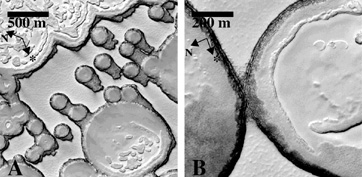New findings show that while Mars has large amounts of water ice, there isn't enough carbon dioxide to warm the planet enough to allow water to flow.

There is water on Mars, but it does not flow
At the poles of Mars there are huge amounts of water in the form of ice that is under a layer of dry ice - ice made of carbon dioxide - but this is not good news for astronauts planning to travel there. The water, some scientists said yesterday, is not suitable for drinking until it is thawed.
The scientists are looking for water flowing on the surface, for example by trying to identify a landscape body such as channels and river valleys. The existence of these channels indicates that in the past the planet was warm enough and wet enough to allow water to remain in a liquid state, and therefore also allow the existence of life similar to that which existed on Earth.
However, new findings published on Thursday, 13/2/02 in the journal Science, show that while Mars has large amounts of ice made of water, there is not enough carbon dioxide to warm the planet enough to allow water to flow.
"There is not a single drop of liquid water on Mars," said researcher Shane Byrne of Caltech. There is only a 3 kilometer thick glacier there, like the Greenland glacier on Earth.
Astronomers have discovered for several decades that the south pole of Mars has a huge amount of frozen carbon dioxide, unlike the north pole. New findings from a device that measures the surface temperature found in the Mars Global Surveyor and Mars Odyssey spacecrafts have shown that the two poles are lacking in the amount of carbon dioxide and contain a very large amount of ice-water, in the layer that resides starting at a depth of 8 meters below the surface.
Both spacecraft sent back high-resolution images of what looked like holes in Swiss cheese, but these holes re-form occasionally as the seafloor warms in the scorching summer. This means that the bottom of these caves, which are about eight meters deep, are made of water ice that heats up, and not of sulfur dioxide ice that rises from a solid state directly to a gaseous state and mixes with the evaporating atmosphere," said Byrne.
The bottom of these holes is on top of a thick layer of water ice in the polar regions. The water ice never warms enough to melt, because it is in an area where the temperature is tens of degrees below zero.
Byrne, along with Prof. Andrew Ingersoll, the signatories of the article say that this situation is bad news for the idea of Earth, an approach according to which heating the surface of the planet will allow the creation of an environment similar to that of the Earth and the melting of water.
Mars used to be warm, but if you want it to warm up again, you have to return huge amounts of carbon dioxide to it because the current amount is not enough to melt the water.
